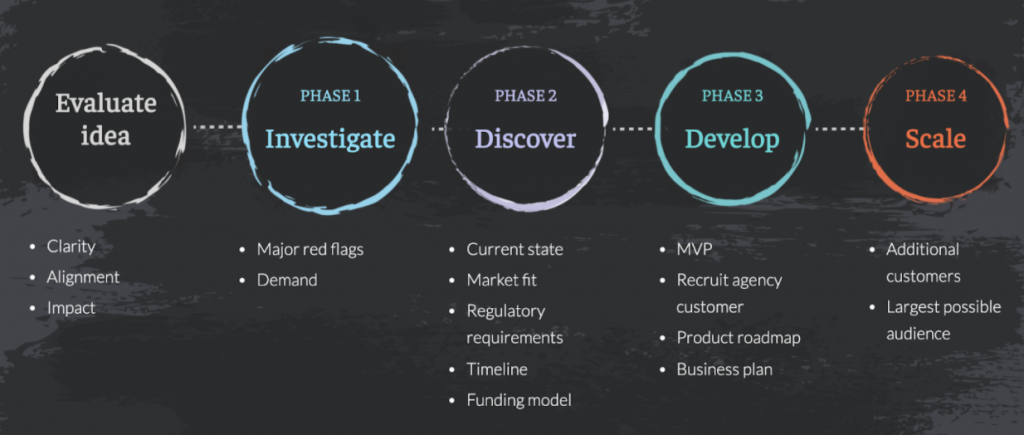Why is it that positive changes in our lives, especially at work, can feel too risky to entertain let alone test? And it doesn’t help that the more senior or entrenched we become in a risk-averse environment, the more likely we are to embody mindsets and behaviors that sabotage progress.
But there are exceptions. Yes, even in government. GovLoop recently spoke with Administrator Robin Carnahan about an ongoing program within the U.S. General Services Administration that she has seen flourish. Carnahan and like-minded colleagues over the years have helped influence this evolving culture of innovation. For her, this work dates back to her earlier days as the founder and former lead of the agency’s tech consultancy arm focused on state and local government.
Our conversation focused largely on GSA’s efforts around 10x. This investment program crowdsources, evaluates, develops and scales ideas from federal employees across agencies that improve how the government serves the public. Cities, such as Los Angeles, pilot similar approaches where funds are set aside to support and scale employee-driven ideas that saved the city money and improved quality of life.
GSA announced this week that it would use 10x program best practices, including equitable evaluation criteria, performing due diligence, and project tracking to reimagine 14 government projects. These initiatives were selected to receive funding under the $150 million provided by the American Rescue Plan Act of 2021.
Whether you’re considering submitting an idea to 10x now (you have through Nov. 16), in the future, or you’d like to apply aspects of this program at your agency, Carnahan shared insights on how organizations can set conditions that cultivate innovation.
De-risk innovation
Considering how much the world has changed over the past 20 months, the riskiest thing the government can do is to stay the same, Carnahan said.
“People’s expectations have changed, the needs have changed, the environment has changed, and we need to change along with it,” she said. That change includes a mindset shift around risk, what it means, how to reduce it and how to take smart risks or bets.
For Carnahan, taking smart bets means small, incremental, intentional steps toward change, which is foundational for the 10x program. De-risking in this sense isn’t about delaying progress but rather using defined timelines and small, initial funding to test ideas, prove impact and potentially scale.
“I’m all about wanting to see progress and value delivered,” she said. “And if things are delivering value, those are the ones you invest [in], and if they’re not, stop. “And that’s often in government, kind of harder than it sounds.”
Make it easy to share ideas and say yes to viable ones
One of the hallmarks of GSA’s 10x program is how accessible it is for employees to share good ideas, understand the selection process and be included in decision-making.
“I often say, ‘Just make it easy for someone to say yes,’” Carnahan noted. “So, we need to make it easy for people to give their new ideas, and innovative ideas, into a place where they can actually be tested and scaled if they’re appropriate.”
10x program evaluators don’t know who the submitters are or what agency they come from until the ideas are selected, ensuring that all ideas are selected based on merit rather than organizational role or stature, according to GSA. The team collects the name of the idea submitter but not their titles, that way they can let them know if their idea was or wasn’t selected to receive 10x phase one funding.
In fiscal 2021, the 10x team received 250 ideas from 89 unique agencies. After a year of targeted outreach, the team received 70% of their ideas outside of GSA. Submissions came from a range of agencies, including the National Foundation on the Arts and the Humanities and the State Department.

The 10x program’s 4-phased approach for selecting, evaluating and scaling new ideas. Source: 10x.gsa.gov
Seek impactful projects
The main focus with any new idea or innovation is impact, Carnahan. She pointed to the launch and expansion of 10x projects such as Login.gov. This is a big deal because governments at all levels grapple with verifying that people are who they say they are to receive a government benefit. Login.gov is “a single sign-on solution for government websites that will enable citizens to access public services across agencies with the same username and password.”
Earlier this year, GSA announced the expansion of its Login.gov solution to state and local governments to much fanfare from the tech community.
But not all projects have a clear trajectory. The U.S. web design standards are one example, Carnahan said. This online library of materials was developed to help agencies provide easily accessible, mobile-friendly websites around standard design principles. It also started as a 10x project, spurred by the desire to clean up and build consistency and accessibility across government websites by focusing on human-centered design.
“Five years later, there have been almost a billion, with a B, data use of things using U.S. website standards,” she said. “Cities and states use it, … other countries use them.”
Although 10x welcomes all ideas, there is a strong focus on projects this round that can deliver digital responses to climate change, addressing issues of equity and justice, and reimagining public engagement.
Have questions or are interested in exploring aspects of 10x that might work at your agency? You can learn more about the program here.




Leave a Reply
You must be logged in to post a comment.